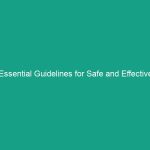Introduction
In any workplace, the Safety and well-being of employees are paramount. Health, Safety, and Environment (HSE) practices are not just regulatory requirements; they are essential for fostering a productive and secure working environment. Adhering to workplace Safety Best Practices can significantly reduce accidents, injuries, and even fatalities. This article will explore the importance of these practices and how they can be effectively implemented in various workplace settings.
As we delve deeper, we’ll examine regulatory frameworks that guide Workplace Safety, highlight Best Practices that can be adopted, and discuss real-world case studies that exemplify successful implementation. By understanding and applying these essential Workplace Safety best practices, organizations can not only comply with legal Standards but also cultivate a culture of Safety that Benefits everyone involved.
Regulatory Frameworks for Workplace Safety
Understanding the regulatory landscape is crucial for any organization striving to improve Workplace Safety. Various agencies, such as the Occupational Safety and Health Administration (OSHA) in the United States, set forth Regulations that dictate safety standards across different industries. These regulations serve as a baseline for employers to ensure their workplaces are safe.
Key Regulatory Bodies
Several key organizations influence Workplace Safety regulations globally:
- Occupational Safety and Health Administration (osha): Established in 1970, OSHA is responsible for ensuring safe and healthy working conditions by enforcing standards and providing Training, outreach, education, and assistance.
- National Institute for Occupational Safety and Health (NIOSH): NIOSH conducts research and makes recommendations to prevent work-related injuries and illnesses.
- Environmental Protection Agency (EPA): The EPA focuses on environmental regulations that affect workplace safety, particularly in industries that deal with hazardous materials.
Understanding Compliance
Compliance with workplace safety regulations is not optional; it is a legal requirement. Organizations must regularly assess their compliance status and implement necessary changes to meet these regulations. Failure to do so can result in hefty fines, legal action, and damage to an organization’s reputation. Regular audits and training are essential components of this process, ensuring that employees are aware of current regulations and how to apply them in their daily tasks.
Best Practices for Workplace Safety
Implementing effective workplace safety Best Practices is essential for minimizing risks. These practices not only protect employees but also enhance overall productivity. Here are some fundamental best practices every organization should consider:
1. Conduct Regular Risk Assessments
Regular risk assessments are a cornerstone of workplace safety. Identifying potential Hazards before they lead to incidents is crucial. This involves evaluating work environments, tools, and processes to pinpoint risks. Engage employees in this process, as they can provide valuable insights into potential Hazards they encounter daily.
2. Implement Safety Training Programs
Training is an ongoing process that equips employees with the knowledge and skills to work safely. Comprehensive safety training programs should cover:
- Emergency Procedures
- Use of Personal Protective Equipment (PPE)
- Proper handling of hazardous materials
- Reporting unsafe conditions
Regular refresher courses are also essential to keep safety protocols fresh in employees’ minds.
3. Promote a Safety Culture
A strong safety culture is characterized by shared values and practices that prioritize safety at all organizational levels. Leadership plays a pivotal role in fostering this culture. When management demonstrates a commitment to safety, employees are more likely to follow suit. Encourage open communication about safety concerns and recognize employees who contribute to a safer workplace.
4. Utilize Technology for Safety Improvements
Technology can significantly enhance workplace safety. From software that tracks incidents and safety compliance to wearable devices that monitor environmental conditions, leveraging technology can lead to more proactive Safety Measures. For example, using drones for inspections in Hazardous Areas can reduce risk to human workers.
5. Regularly Review and Update Safety Policies
Workplace conditions and regulations are constantly evolving. Therefore, it is vital to regularly review and update safety policies to reflect current standards and best practices. This ensures that all employees are working within the latest Safety Guidelines and that the organization remains compliant with regulations.
Case Studies in Workplace Safety
Real-world examples can provide valuable insights into the implementation of workplace safety best practices. Here are two case studies that highlight the positive impact of effective Safety Measures:
Case Study 1: Manufacturing Industry
A large manufacturing company faced high rates of workplace injuries due to machinery accidents. After conducting a thorough risk assessment, they discovered that many incidents were due to a lack of proper training and outdated machinery. In response, the company implemented a comprehensive training program that included:
- Hands-on training with new equipment
- Regular safety drills
- Clear signage and instructions near machinery
As a result, the company reported a 40% reduction in accidents within the first year, demonstrating the effectiveness of proactive safety measures.
Case Study 2: Office Environment
An office environment implemented a wellness program that focused on ergonomics to reduce repetitive strain injuries. They provided sit-stand desks, ergonomic chairs, and regular workshops on proper posture and stretching exercises. Over time, the office saw a significant decrease in employee complaints related to musculoskeletal issues. This case illustrates how workplace safety best practices extend beyond traditional industrial settings and can be effectively applied in office environments to enhance employee well-being.
Challenges in Implementing Workplace Safety Best Practices
While implementing workplace safety best practices is essential, organizations often face challenges that can hinder progress. Understanding these challenges is the first step in overcoming them:
1. Resistance to Change
Employees may resist changes to safety protocols due to comfort with existing practices. It is crucial to communicate the reasons behind changes and involve employees in the process. By fostering a sense of ownership, organizations can reduce resistance and encourage compliance.
2. Lack of Resources
Some organizations may struggle with limited resources, making it difficult to implement comprehensive safety programs. Prioritizing safety in the budget and seeking external funding or partnerships can help alleviate these constraints. Additionally, leveraging technology can improve safety measures without significant capital investment.
3. Inadequate Training
Organizations sometimes underestimate the importance of thorough training. Inadequate training can lead to misunderstandings of safety protocols and increased risk. Investing in robust training programs ensures employees are equipped with the necessary knowledge and skills to maintain a safe working environment.
Future Trends in Workplace Safety
The landscape of workplace safety is continually evolving. Staying informed about trends can help organizations remain proactive in their safety efforts. Some emerging trends include:
1. Increased Use of Artificial Intelligence (AI)
AI is revolutionizing workplace safety by enabling predictive analytics that can identify potential hazards before they occur. AI-driven tools can analyze data from various sources to forecast risks and recommend preventive measures.
2. Focus on Mental Health
As awareness of mental health issues grows, organizations are increasingly recognizing the importance of mental well-being in workplace safety. Implementing programs that support mental health can lead to improved employee morale and productivity, ultimately contributing to a safer work environment.
3. Remote Work Safety Considerations
The rise of remote work has introduced new safety considerations. Employers must adapt their safety policies to address potential hazards in home office setups. Providing resources and guidelines for ergonomic home workspaces is becoming increasingly important.
Conclusion
Workplace safety is an ongoing commitment that requires continuous effort and adaptation. By understanding and implementing essential workplace safety best practices, organizations can protect their most valuable asset: their employees. From adhering to regulatory frameworks to fostering a culture of safety, every step taken toward improving safety is a step toward a more productive and secure workplace.
Encourage your organization to take a proactive stance on safety by regularly reviewing practices, engaging employees, and staying informed about emerging trends. Remember, prioritizing safety not only complies with regulations but also enhances employee morale and productivity. Let’s work together to create safer workplaces for everyone!


